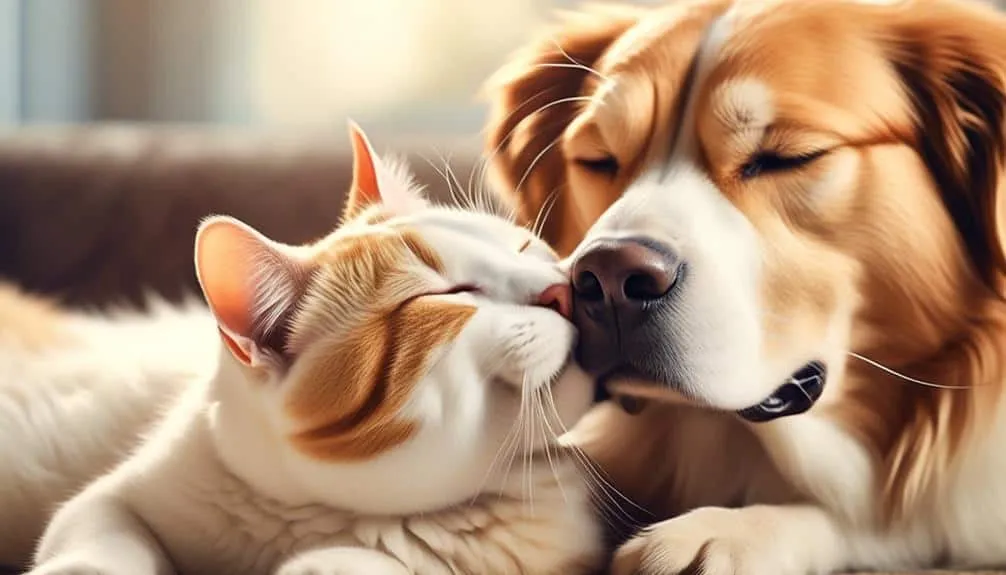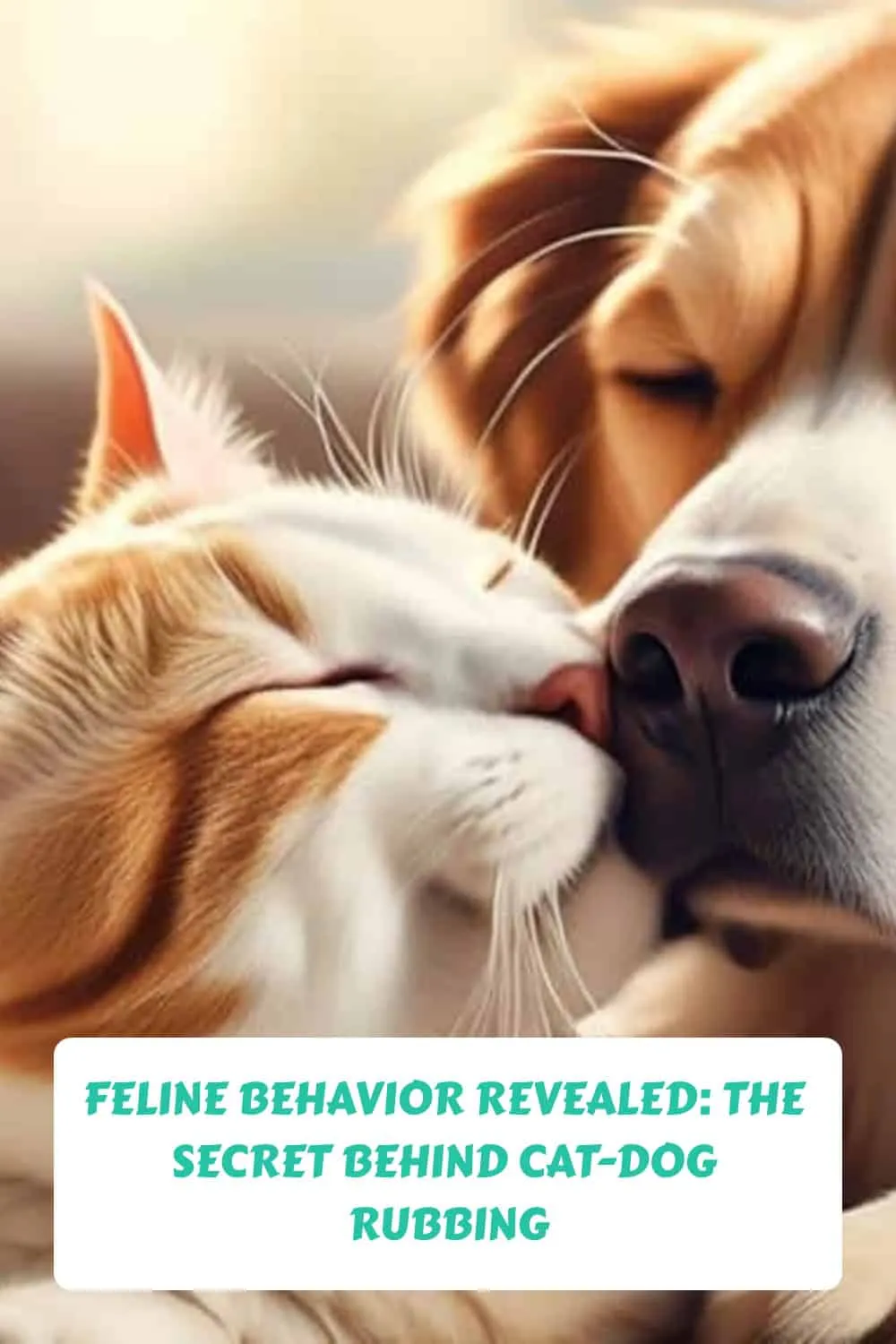The Best Fluffy Pancakes recipe you will fall in love with. Full of tips and tricks to help you make the best pancakes.

Have you ever witnessed the peculiar sight of your cat rubbing against your dog? It's like watching two different species engaged in an intricate dance, each with their own hidden motivations. Like a cryptic puzzle waiting to be unraveled, the secret behind this curious behavior holds a fascinating world of feline behavior. As you observe this unique interaction, you may start to notice the subtleties in their movements and postures, as if engaging in a silent conversation. Understanding these signs can provide insight into their relationship, shedding light on how animals communicate despite their differences—feline body language explained. This captivating interplay reveals much about their instincts, emotional states, and the bonds they can form beyond species boundaries. As you observe this unique interaction, it’s essential to understand that such behaviors often stem from instinctual drives and social dynamics. The phenomenon can reveal much about their individual personalities and social hierarchies, intertwining their worlds in unexpected ways. In this light, feline biting behavior explained further uncovers the complexities of their communication and emotional expressions, enriching our understanding of these beloved pets.
In this discussion, we will explore the reasons behind cat-dog rubbing, shedding light on the complex dynamics between these two animals. From territory marking to non-verbal communication, prepare to unravel the enigmatic bond between cats and dogs.
Key Takeaways
- Cats rub against dogs to claim them as their territory and warn other cats to stay away from the dog.
- Rubbing transfers pheromones that convey territory and provide emotional, reproductive, or health status information.
- Rubbing and head butting indicate a happy and content cat, showing affection and comfort with the dog's presence.
- Cats may rub against dogs out of curiosity to gather information about their recent encounters and identify scents.
Territory and Scent
Cats rub against dogs to claim them as their territory, using their scent glands to convey territorial messages to other cats. Cats have scent glands on their forehead, lips, chin, and head. Rubbing transfers pheromones that convey territory to other cats.
Dogs may find the smell interesting, but they don't respond the same way as cats. Rubbing allows cats to warn other cats to stay away from the dog. Rubbing against the dog transfers the cat's scent onto them.
Cats have a strong sense of smell with over 200 million scent receptors. Transferring scent helps cats identify and locate objects or animals. Cats create a group scent by including the dog in their scent marking.
Rubbing indicates the cat's comfort and acceptance of the dog.
Communication
When it comes to the interaction between cats and dogs, understanding their different ways of communication is crucial.
Cats and dogs have unique methods of conveying information to each other. Cats may rub against dogs to communicate with other cats, using pheromones released during rubbing to provide emotional, reproductive, or health status information. While dogs may also pick up on these pheromones, their interpretation may differ from cats. This can lead to miscommunication between the two species.
Additionally, rubbing allows cats to bond with dogs through scent. By transferring their scent onto the dog, cats create a group scent, indicating their acceptance and comfort with the dog's presence.
Understanding the role of communication and bonding through scent can help improve the relationship between cats and dogs.
Greeting
To convey a friendly greeting, cats often initiate contact with dogs by rubbing their heads against them. This behavior serves several purposes and has an impact on the dynamics of the cat-dog relationship.
Reasons for cat-dog rubbing:
- Establishing familiarity: By rubbing their heads against dogs, cats transfer their scent, helping them recognize and accept the dog as part of their social group.
- Showing affection: Head rubs indicate a happy and content cat, expressing their affection and comfort with the dog's presence.
- Seeking attention: Cats may also rub against dogs to seek attention and affection from them, reinforcing the bond between the two animals.
Impact on cat-dog relationship dynamics:
- Cat-dog rubbing promotes positive interactions and strengthens the bond between the animals.
- It helps establish a sense of trust and familiarity, leading to a more harmonious coexistence.
- The act of rubbing can also create a sense of comfort and security for both the cat and the dog.
Understanding the reasons behind cat-dog rubbing and its impact on their relationship dynamics can help pet owners foster a peaceful and loving environment for their furry friends.
Curiosity
By engaging in rubbing and sniffing behaviors, cats demonstrate their innate curiosity towards dogs and their surroundings. Cats have a special olfactory organ called the vomeronasal organ, which plays a crucial role in their scent recognition abilities. When cats rub against dogs, they may be trying to gather information about the dog's recent encounters and the scents they carry.
The vomeronasal organ helps cats identify other animals and detect specific scents. By rubbing and sniffing the dog, the cat is essentially investigating and exploring its environment through smell. This behavior allows cats to satisfy their curiosity and gain knowledge about the world around them.
Cat Dominance and Social Behaviors
Cats' social behaviors and dominance dynamics in relation to dogs are complex and distinctive, reflecting their unique interactions within the feline and canine species.
While cats rarely try to assert dominance over dogs, social hierarchies in both species are fluid and can change. Cats establish dominance over other cats through specific behaviors, but rubbing against something isn't a way for cats to show dominance.
Cats and dogs can get along and live harmoniously, but it's important to understand that overstimulation can sometimes occur when a cat rubs against a dog. This can irritate the dog, but it isn't done on purpose by the cat.
Cat rubbing is a natural behavior between cats and dogs, and understanding their social behaviors can help foster a positive relationship between the two species.
Scent Glands and Pheromones
Scent glands and pheromones play a crucial role in the communication and social interactions between cats and dogs. When cats rub against dogs, they aren't only marking their territory but also transferring pheromones that convey important information.
Cats have scent glands on their forehead, lips, chin, and head, and rubbing against the dog allows them to warn other cats to stay away and create a group scent that includes the dog. The pheromones released during rubbing provide emotional, reproductive, or health status information to other cats.
While dogs may find the smell interesting, they may not interpret it in the same way as cats. Cats use scent as a form of communication with non-human animals, and rubbing against a dog can be a way for them to greet, show affection, or satisfy their curiosity about the dog's recent encounters.
Understanding the role of scent and pheromones is key to comprehending the complex behavior of cat-dog rubbing.
Cats' Sense of Smell
The powerful sense of smell possessed by cats allows them to gather important information about their surroundings and other animals. Cats' olfactory capabilities are truly remarkable, with over 200 million scent receptors in their noses. This enables them to detect and distinguish a wide range of scents, including those left by other animals. When it comes to scent marking behaviors, cats rely on their sense of smell to identify and locate objects or animals.
Here's how cats' sense of smell contributes to their scent marking behaviors:
- Recognition: Cats use their sense of smell to recognize familiar scents and identify other animals.
- Communication: Through scent marking, cats convey information to other cats about their emotional state, reproductive status, or overall health.
- Identification: By rubbing against a dog and transferring their scent, cats include the dog in their group scent, helping them to identify and accept the presence of the dog.
Cats' sense of smell plays a vital role in their scent marking behaviors, allowing them to communicate, establish territory, and form social bonds with other animals.
Dogs' Perception of Rubbing
Dogs perceive rubbing as a form of communication, but their interpretation may differ from that of cats. While cats use rubbing to convey information to other cats, dogs may not fully understand this form of communication.
When a cat rubs against a dog, the dog's reaction can vary. Some dogs may find the smell interesting, while others may not respond at all. This difference in interpretation can have behavioral implications.
Cats use rubbing to claim territory and warn other cats to stay away from the dog. However, dogs may not perceive this territorial marking in the same way.
It's important to understand that cats and dogs have different ways of communicating with each other, and their reactions to rubbing can vary based on their individual personalities and experiences.
Non-Verbal Communication
When cats and dogs interact, their non-verbal communication plays a significant role in establishing their relationship and understanding each other's intentions. This non-verbal communication includes feline body language and the canine response to it. Here are three key points to consider:
- Posture and gestures: Cats use their body language to convey their emotions and intentions. For example, a relaxed and confident cat may approach a dog with a slow and deliberate walk, while a fearful cat may exhibit signs of aggression or try to escape.
- Tail and ear movements: The position and movement of a cat's tail and ears can indicate its mood. A wagging tail or erect ears may signal excitement or curiosity, while a tucked tail or flattened ears can indicate fear or aggression. Dogs can observe these cues to understand the cat's emotional state.
- Eye contact and vocalizations: Cats communicate through subtle eye movements and vocalizations. Dilated pupils may indicate fear or aggression, while slow blinking or a relaxed gaze can signal trust and affection. Dogs may respond to these cues by showing submission or attempting to establish dominance.
Understanding and interpreting these non-verbal cues can help cats and dogs communicate effectively and build a harmonious relationship.
Harmonious Coexistence
To promote a harmonious coexistence between cats and dogs, it's important to understand their unique social dynamics and provide them with appropriate environmental enrichment and positive reinforcement training.
Cats and dogs have different ways of communicating and expressing themselves, and it's crucial to recognize and respect these differences. While cats may rub against dogs as a form of communication, greeting, or to satisfy their curiosity, the dog's response may not always align with the cat's intentions.
However, when given the right environment and training, cats and dogs can live together peacefully and even benefit from each other's presence. The benefits of coexistence include companionship, socialization, and mental stimulation for both animals.
Conclusion
Congratulations! You're now an expert on the mysterious world of cat-dog rubbing.
Armed with knowledge about territory marking, communication, and the intriguing sense of smell, you can impress your friends with your newfound expertise.
Remember, when your cat rubs against your dog, it's not just a random act of affection, but a sophisticated form of feline communication.
So next time you witness this peculiar behavior, sit back, relax, and enjoy the fascinating world of cat-dog dynamics.










